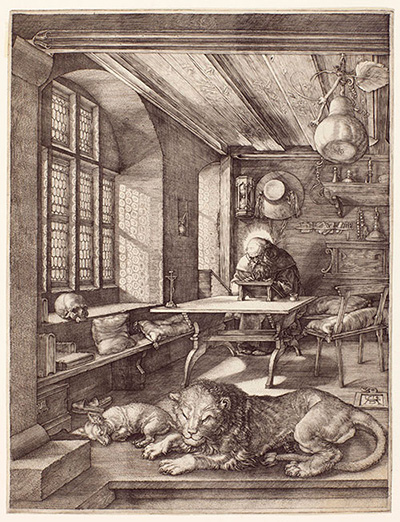News Release - Exhibition Marking the 500th Anniversary of the Protestant Reformation Opens Oct. 28
Posted on Wed., Oct. 11, 2017
"The Reformation: From the Word to the World" On view Oct. 28, 2017–Feb. 26, 2018 | At The Huntington Library, Art Collections, and Botanical Gardens
Library, West Hall

Albrecht Dürer (1471–1528), St. Jerome in His Study, 1514, engraving. The Huntington Library, Art Collections, and Botanical Gardens, Edward W. and Julia B. Bodman Collection.
SAN MARINO, Calif.—The Huntington Library, Art Collections, and Botanical Gardens will mark the 500th anniversary of the Protestant Reformation with an exhibition that explores the power of the written word as a mechanism for radical change. The exhibition draws almost exclusively from The Huntington’s collections and includes about 50 rare manuscripts, books, and prints made between the 1400s and 1648 (the end of the Thirty Years War). “The Reformation: From the Word to the World” is on view in the West Hall of the Library from Oct. 28, 2017 through Feb. 26, 2018.
On Oct. 31, 1517, German priest Martin Luther, who believed church doctrines created an ever-growing gap between believers and God, is said to have posted a document of what today are called the “95 theses”—his specific disputes—to the door of a church in Wittenberg to contest recent practices of the Catholic Church. Luther was looking to stimulate thoughtful debate that would clear away corruption and pomp, and reform the Church. What followed was a flurry of written arguments and ideas put forward by scholars, clerics, statesmen, and lay believers to fuel a movement called the Reformation.
“This was an act of protest, yet it was also an act of faith,” said Vanessa Wilkie, the William A. Moffett Curator of Medieval Manuscripts and British History at The Huntington, and the curator of the exhibition. “Luther was closely tied into larger debates taking place across Europe. It’s important to note that he was not the only cleric in the early 16th century to publish theological justifications for his beliefs and actions. Luther’s reformation was just one part of the Reformation. And none of it would have been possible without manuscripts and printed books.”
The spark of the Reformation spread through reading, writing, and printing practices of the period. Reformers and counter-reformers would often reinterpret older images and ideas to fit the current moment. Differing ideas and theological beliefs, however, soon gave way to popular violence, warfare, and ultimately colonial conquest. While “The Reformation: From the Word to the World” focuses on Europe and addresses important historical figures, religious wars of the period, the Catholic Church’s response to the emergence of Protestant groups, and the political ideologies of countries with state religions, the main focus is on the power of the written word to effect radical change. Scholars, clerics, statesmen, and lay believers disseminated texts to articulate their faiths, ignite reforms, and attack adversaries. European governments and religious councils banned books to minimize the spread of works they deemed to be dangerous, regain control, and combat people and ideas they believed to be radical. Words, texts, images, and prints blurred the divisions between thinkers, heroes, and martyrs, said Wilkie. “The Reformation did not just play out in pulpits and on battlefields—it lived on the page.”
Items on display include a 1514 papal indulgence (a remission of the punishment of sin), an incunable (a book printed before 1501) annotated by Martin Luther, early 16th-century prints by Albrecht Dürer, the 1573 original manuscript proclamation issued and signed by Queen Elizabeth I requiring the use of the Book of Common Prayer, and a 15th-century manuscript of the Brut Chronicles in which a later reformer “erased” the word “Pope” from the text.
While the exhibition addresses the power of the written word and the relationship between it and radical change within a specific historical moment and geographical region, the themes and larger questions posed in the exhibition resonate across time in different ways.
“Voices from the past survive primarily through texts and images, but today we convey our own messages in a variety of ways: podcasts, social media, fashion, and even protest posters,” said Wilkie. “This exhibition touches on how we reinterpret and transform words and images from the past to engage in debates of our own time. In the end, it asks, ‘“What do you want to tell the world? How do you want to share your message?’”
This exhibition is made possible by the generous support of the Robert F. Erburu Exhibition Endowment.